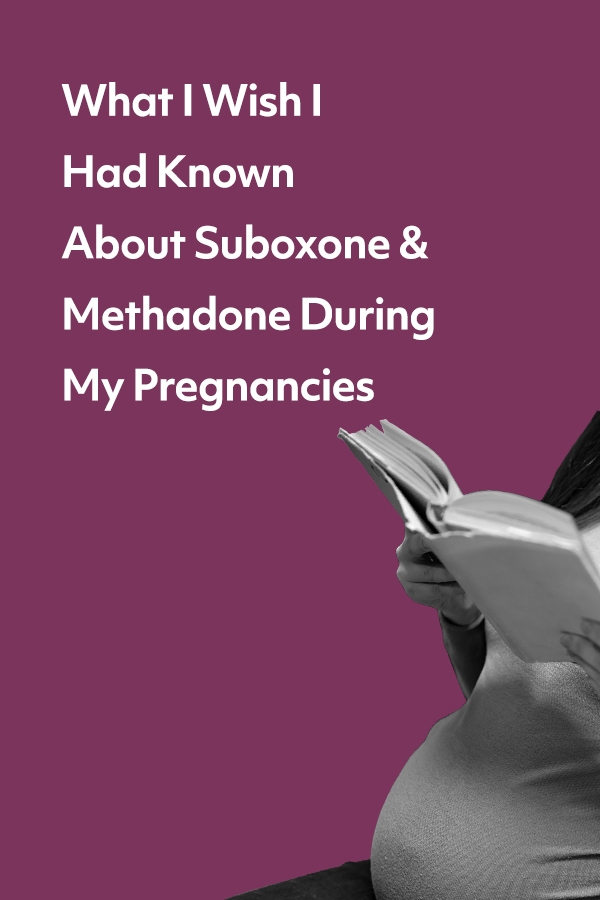A firsthand look at medically-assisted treatment during pregnancy, with experience using both Suboxone and methadone.
I am in a unique position to write about my experiences with pregnancy and medically-assisted treatment (MAT) for opioid addiction. I’ve used both of the mainstream MAT options during two separate pregnancies. I used methadone during the first of these two pregnancies, and buprenorphine (Suboxone) during the second. In fact, I also gave birth before ever using opioids, so I even have a “baseline” pregnancy to use as comparison.
Seeing through the controversy and stigma around medically-assisted treatment
Medically-assisted treatment is a hotly contested subject even for patients who are not pregnant. Add in a pregnancy, and people can become downright vicious. Some states even prosecute women who use MAT—usually methadone—while pregnant, if their children experience Neonatal Abstinence Syndrome (withdrawal). They do this even though neonatal withdrawal is a very real possibility and not the mother’s fault.
One of the side-effects of the stigma and fear surrounding MAT during pregnancy is that women receive a lot of misinformation. Some of this misinformation even comes from providers, who are either ill-informed themselves, or feel that lying somehow serves the patient’s best interests. I personally do not agree that lying or manipulation ever serves a patient’s best interests, and especially not when pregnancy is concerned. To help combat that, I’ve written up this three-part series for WorkIt Health about the things I wish I had known when I was pregnant and on MAT.
“One of the side-effects of the stigma and fear surrounding MAT during pregnancy is that women receive a lot of misinformation. ”
There is more stigma about methadone than buprenorphine
As a whole, there is more stigma when it comes to methadone use than buprenorphine use. This is potentially associated with several different factors. For example, methadone is a full-opioid agonist, whereas buprenorphine is a partial-opioid agonist. This leads many people to believe that methadone is “worse” than buprenorphine, or that it has the potential to gives users a “legal high.”
Methadone is also popularly correlated with low-income people who are treating injection heroin addiction, while buprenorphine is perceived to be a medication taken by people who were misusing pharmaceuticals. These stereotypes are ill-informed. Both medications can be and are used to treat addiction to street drugs and prescription drugs—not that the distinction should matter in the first place. Furthermore, many people have to pay high fees for the cost of methadone. This, along with the heavy regulation of methadone, makes it difficult for low-income patients to access in some areas. Many states that cover methadone through Medicaid also cover buprenorphine. While some buprenorphine doctors do charge extra fees that aren’t typically associated with methadone, the class divide often presents in a specific area for both medicines, or neither.
Despite the stigma, however, doctors typically advise pregnant women coming straight from an opioid addiction to use methadone. This is partly because induction to buprenorphine requires a brief period of withdrawal, which can cause complications during pregnancy. It’s also simply because methadone has been on the market longer, so there have been more tests demonstrating its relative safety for use during pregnancy. Nonetheless, buprenorphine has also tested safely during pregnancy trials. If a doctor oversees the brief withdrawal period, a pregnant woman should be able to induct on buprenorphine without issue. Basically, if buprenorphine is the medication-assisted treatment you wish to take during pregnancy, you should absolutely have the agency to make that choice.
“If buprenorphine is the medication-assisted treatment you wish to take during pregnancy, you should absolutely have the agency to make that choice.”
Neonatal Abstinence Syndrome and medically-assisted treatment
Although Neonatal Abstinence Syndrome (NAS) is a very real possibility with both medications—and it’s also possible for your child to experience no withdrawal from either medication—buprenorphine in general has been shown to produce less severe and prolonged withdrawal symptoms, and less neonatal withdrawals in general.
My experience mirrored the statistics. The daughter I had while using methadone experienced moderate-to-severe withdrawal symptoms for about a month and a half. The daughter I birthed while using buprenorphine had very mild symptoms for under a week. Of course, stigma and location may also have played a large role in this. With the first, I gave birth while on methadone in South Florida. There, my infant was almost immediately placed in the Neonatal Intensive Care Unit, under harsh bright lights and away from her family. I was not allowed to breastfeed her. I couldn’t room with her. On one occasion was even barred from holding her, even though I had done nothing wrong.
On the other hand, I gave birth to my second daughter in Seattle, Washington while on buprenorphine. There, we were allowed to room-in together during her stay. I was given free access to breastfeeding opportunities—in fact, she only weaned at over two years of age. I was never stopped from holding her, and was treated with much more warmth and respect by the hospital staff in Seattle than in South Florida. More and more research is showing that breastfeeding and maternal contact are the best cures for NAS, so the deprivation my child and I experienced in Florida likely affected her withdrawal experience significantly.
“More and more research is showing that breastfeeding and maternal contact are the best cures for NAS.”
Buprenorphine and methadone are different, but both are good options during pregnancy
Buprenorphine and methadone are both different drugs that can be safely used during pregnancy to treat opioid addiction. If you are considering using one, know that both are good choices—but that nobody has the right to bully or pressure you to use one over the other. If you feel the withdrawal symptoms likely to occur during buprenorphine induction are too dangerous for you and you’d rather use methadone, don’t let anyone guilt you for that decision. Likewise, if you don’t feel methadone is right for you, don’t allow doctors to pressure you to choose it over buprenorphine simply because it’s been around longer.
Keep your eyes out for the next post in this series, in which I’ll tackle some ways you can reduce the chances of experiencing medication side-effects and NAS.









